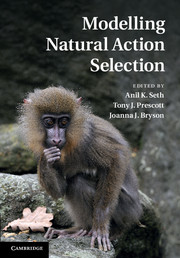Book contents
- Frontmatter
- Contents
- Foreword
- Preface
- Contributors
- 1 General introduction
- Part I Rational and optimal decision making
- Part II Computational neuroscience models
- Part III Action selection in social contexts
- 18 Introduction to Part III: action selection in social contexts
- 19 Agent-based models as scientific methodology: a case study analysing the DomWorld theory of primate social structure and female dominance
- 20 An agent-based model of group decision making in baboons
- 21 Endogenous birth and death of political parties in dynamic party competition
- 22 On optimal decision making in brains and social insect colonies
- 23 State-dependent foraging rules for social animals in selfish herds
- Index
- Plate section
- References
23 - State-dependent foraging rules for social animals in selfish herds
from Part III - Action selection in social contexts
Published online by Cambridge University Press: 05 November 2011
- Frontmatter
- Contents
- Foreword
- Preface
- Contributors
- 1 General introduction
- Part I Rational and optimal decision making
- Part II Computational neuroscience models
- Part III Action selection in social contexts
- 18 Introduction to Part III: action selection in social contexts
- 19 Agent-based models as scientific methodology: a case study analysing the DomWorld theory of primate social structure and female dominance
- 20 An agent-based model of group decision making in baboons
- 21 Endogenous birth and death of political parties in dynamic party competition
- 22 On optimal decision making in brains and social insect colonies
- 23 State-dependent foraging rules for social animals in selfish herds
- Index
- Plate section
- References
Summary
Summary
Many animals gain benefits from living in groups, such as a dilution in predation risk when they are closely aggregated (referred to as the ‘selfish herd’). Game theory has been used to predict many properties of groups (such as the expected group size), but little is known about the proximate mechanisms by which animals achieve these predicted properties. We explore a possible proximate mechanism using a spatially explicit, individual-based model, where individuals can choose to rest or forage on the basis of a rule of thumb that is dependent upon both their energetic reserves and the presence and actions of neighbours. The resulting behaviour and energetic reserves of individuals, and the resulting group sizes, are shown to be affected both by the ability of the forager to detect conspecifics and areas of the environment suitable for foraging, and by the distribution of energy in the environment. The model also demonstrates that if animals are able to choose (based upon their energetic reserves) between selecting the best foraging sites available, or moving towards their neighbours for safety, then this also has significant effects upon individuals and group sizes. The implications of the proposed rule of thumb are discussed.
Introduction
When animals form groups, it is often assumed that each individual faces various costs and benefits of group membership (Giraldeau and Caraco, 2000; Krause and Ruxton, 2002; Pulliam and Caraco, 1984). For example, within a foraging group, benefits could come through an increased likelihood of finding food or detecting predators, while costs could come through increased competition for resources, or increased visibility to predators. Much theoretical work has been conducted examining how the trade-off between these costs and benefits can determine the stable size of a group (Clark and Mangel, 1984; Ekman and Rosander, 1987; Giraldeau and Caraco, 2000; Higashi and Yamamura 1993; Sibly, 1983), and how these predictions match with empirical observations (Krause and Ruxton, 2002). However, although these studies have considered which group sizes should be stable from a functional perspective, little work has been conducted examining the proximate mechanisms resulting in the formation of these groups: recent models (e.g., Flierl et al., 1999; Juanico et al., 2003) have considered the actions of individuals following extremely simple rules of thumb. However, as noted by Krause and Ruxton (2002), little consideration has been given to making these rules realistic. State-dependent models of behaviour (Clark and Mangel, 2000; Houston and McNamara, 1999) offer us a means of predicting realistic rules, by considering which behaviours at a particular moment in time an animal with a given state set (such as its energy reserves, or the environment it currently occupies) should conduct in order to maximise some measure of its fitness. Therefore, unlike previous spatially-explicit models considering group formation behaviour, the model presented in this chapter bases its rules upon the results of state-dependent models (Rands and Johnstone, 2006; Rands et al., 2003, 2008).
- Type
- Chapter
- Information
- Modelling Natural Action Selection , pp. 523 - 537Publisher: Cambridge University PressPrint publication year: 2011



